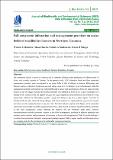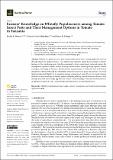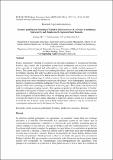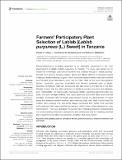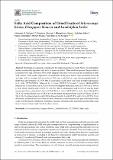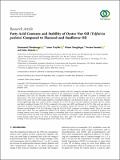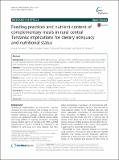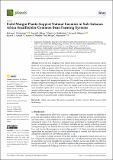Browsing Research Articles [LISBE] by Title
Now showing items 341-360 of 969
-
Factors associated with infectious bursal disease vaccination failure in Dar es salaam, Tanzania
(Journal of Veterinary Medicine and Animal Health, 2020-09)Infectious bursal disease (IBD) is a viral infection that affects young chicks. The IBD outbreaks in vaccinated chickens are reported in Tanzania frequently. The current study was conducted to find out the possible causes ... -
Factors associated with poor compliance to rabies post-exposure prophylaxis among dog bite victims in Maswa District in Tanzania: a cross-sectional study
(Public health, 2024-05-22)Introduction: administering rabies post-exposure prophylaxis (PEP) in a timely and appropriate manner remains the most fundamental measure for preventing human rabies. However, a number of barriers to accessing and ... -
Factors associated with stunting in Dodoma region, Tanzania
(African Journal of Food, Agriculture, Nutrition and Development, 2018-12)Child undernutrition is a major public health concern, claiming the lives of numerous children below five years of age in the developing world. The objective of this study was to assess the factors associated with stunting ... -
Factors Contributing to Retention in Care and Treatment Adherence Among People Living With HIV Returning to Care in South-Eastern Tanzania: A Qualitative Study
(Taylor & Francis online, 2025-02-04)Background People living with HIV (PLHIV) with good adherence to antiretroviral therapy (ART) achieve good health outcomes. However, treatment interruptions remain a major challenge, particularly in rural Africa. This ... -
Factors influencing the sustainability of homestead vegetable production intervention in Rufiji, Tanzania: A cross-sectional mixed methods study
(PLOS Global Public Health, 2022-09-20)There is growing evidence that home vegetable gardening interventions improve food security and nutrition outcomes at the family level. Sustainability of many of these community interventions remain a challenge. This study ... -
Factors Influencing Willingness to Pay for Multiple Micronutrient Powder (Virutubishi) Supplements for Young Children in Arusha, Tanzania
(Journal of Health & Medical Economics, 2018-11-21)Background: Multiple micronutrient powders have shown a positive effect on anaemia prevention in children 6-59 months. For the purposes of uptake and sustainability, we explored ‘‘willingness to pay’’ for these health ... -
Fall armyworm infestation and management practices on maize fields of smallholder farmers in Northern Tanzania
(Journal of Biodiversity and Environmental Sciences (JBES), 2019-10-30)Fall armyworm (FAW) is native to America and is currently affecting maize production in different parts of Africa, and recently reported in Tanzania. In the present study, FAW infestation levels and their associated ... -
Farmers’ insights and practices on sustainable soil nutrient and pest management in semi-arid Eastern Africa
(MDPI, 2025-03-12)The need to increase agricultural production for food, fiber, and feed for a growing population is a global call. Sub-Saharan Africa currently experiences declining soil fertility and increasing pest pressures affecting ... -
Farmers’ Knowledge on Whitefly Populousness among Tomato Insect Pests and Their Management Options in Tomato in Tanzania
(MDPI, 2023-02-13)Whitefly is a populous insect pest among tomato insect pests, causing significant crop loss through direct and indirect attacks. The current study aimed to assess the knowledge of tomato farmers on the populousness of ... -
Farmers’ Knowledge, Perceptions and Practices in Managing Weeds and Insect Pests of Common Bean in Northern Tanzania
(MDPI, 2019-07-28)Weeds and insect pests are among the serious constraints in common bean production in most rural communities. A survey of 169 smallholder farmers was conducted in two common bean-growing districts in northern Tanzania. ... -
Farmers’ participatory breeding of Lablab (Lablab purpureus (L.) Sweet): A nutritional, food security and climate smart crop in northern Tanzania
(Research application summary, 2022)Farmer participatory breeding is considered an alternative technique to conventional breeding. Farmers play a major role in germplasm conservation, maintenance and selection of preferred traits especially in neglected ... -
Farmers’ Participatory Plant Selection of Lablab (Lablab purpureus (L.) Sweet) in Tanzania
(Frontiers in Plant Science, 2022-06-23)Farmer-participatory breeding approach is an important component in the crop improvement of lablab (Lablab purpureus (L.) Sweet). The study was carried out to obtain the knowledge, practices and preferences of lablab ... -
Farmer’s Knowledge on Thaumatotibia Leucotreta (Meyrick) an Economic Pest of Avocado Production in Tanzania
(Taylor & Francis online, 2025-01-20)Thaumatotibia leucotreta (Meyrick) is a Lepidopteran pest that feeds on more than 70 plant species, both wild and cultivated. A study was carried out in Tanzania to assess farmer’s knowledge regarding the invasion of pests ... -
Farming systems and soil fertility management practices in smallholdings on the southern slopes of Mount Kilimanjaro, Tanzania
(Frontiers, 2024-02-16)In the northern part of Tanzania, the slopes of Mount (Mt.) Kilimanjaro are the most important areas, both in terms of socio-economic development and ecological succession. The main agricultural systems in the area are ... -
Fatty Acid Composition of Dried Fruits of Sclerocarya birrea, Diospyros blancoi and Landolphia kirkii
(MDPI, 2017-11-17)Wild fruits are commonly consumed in the rural communities of SouthAfrica. The information on their nutritionally important fatty acids is, however, limited. Threewild fruit species, Diospyros blancoi, Landolphia kirkii ... -
Fatty Acid Contents and Stability of Oyster Nut Oil (Telfairia pedata) Compared to Flaxseed and Sunflower Oil
(Hindawi, 2021-11-21)The selection of healthy fats for consumption is important. Linoleic acid (LA) (omega-6) and alpha-linolenic acid (ALA) (omega-3) are essential polyunsaturated fatty acids required for the maintenance of good health; ... -
Feeding practices and nutrient content of complementary meals in rural central Tanzania: implications for dietary adequacy and nutritional status
(Kulwa et al. BMC Pediatrics, 2015-11-06)Background: Stunting and micronutrient deficiencies are significant health problems among infants and young children in rural Tanzania. Objective of the study was to assess feeding practices, nutrient content of complementary ... -
Field Margin Plants Support Natural Enemies in Sub-Saharan Africa Smallholder Common Bean Farming Systems
(MDPI, 2022-03-28)Flower-rich field margins provide habitats and food resources for natural enemies of pests (NEs), but their potential, particularly in the tropics and on smallholder farms, is poorly understood. We surveyed field margins ... -
Field Margin Vegetation in Tropical African Bean Systems Harbours Diverse Natural Enemies for Biological Pest Control in Adjacent Crops
(MDPI, 2019-11-14)Non-crop vegetation around farmland can be valuable habitats for enhancing ecosystem services but little is known of the importance of field margins in supporting natural enemies of insect pests in tropical agriculture. ... -
Field vaccination of locally-owned cattle against malignant catarrhal fever under environmentally challenging conditions in Tanzania
(Elsevier, 2025-01-25)Malignant catarrhal fever (MCF), caused by alcelaphine herpesvirus-1 (AIHV-1) transmitted from wildebeest, is a lethal cattle disease with significant impacts on East African pastoralists. Development of a live attenuated ...







